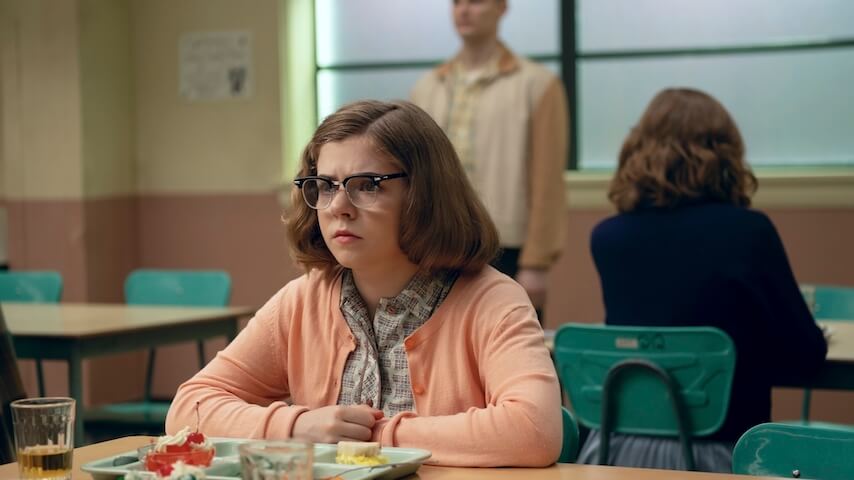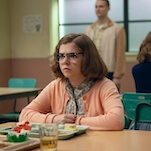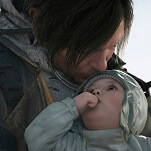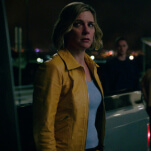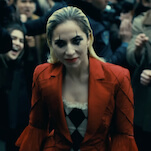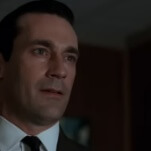I’m hard-pressed, four episodes in, to pick which element of IT: Welcome To Derry’s plot feels more at odds with Stephen King’s original novel: the presence of a storyline about the U.S. government hunting down magical rocks to turn Pennywise The Dancing Clown into a war-ending “Weapon” to cook the Commies, or the presence of parents who are actively working to save their kids from getting messily devoured.
Suffice it to say that parenthood is not an active, or at least a positive, concern in 1986’s IT. As part of generating a concentrated blast of coming-of-age energy rooted in a horror-soaked version of latchkey-kid syndrome, King transforms the parents of his Losers Club into non-entities at best and forces of outright malevolence at worst. (Beverly Marsh’s creepingly predatory father is the obvious candidate for the latter category, but Eddie Kaspbrak’s hypochondriac mom is another fine contender. It’s telling that one of the only parents depicted as a positive force in their children’s lives is our man Will Hanlon, and he’s dead before his son Mike is out of high school.) Part of the horror that IT feeds on is that your parents cannot, and will not, save you from it. Indeed, one of its favorite flavors of terror is the classic shame that greets most kids when they go running to their parents to save them from the Boogeyman, to dispel the horrible thing lurking in the corner of their eyes and the back of their brains. Not only are you scared, kid: You’re also wrong, silly, an inconvenient and childish bother. Get the fuck back to your bed (which nothing is lurking underneath). And that, of course, is when IT strikes.
In that light, there’s something almost radical about “The Great Swirling Apparatus Of Our Planet’s Function” showing both Leroy and Charlotte Hanson taking their son’s reports that something bad is going on in Derry at least somewhat seriously. Leroy has some advantages here, in terms of bulking up his credulity—not just all the time he’s been spending in the weird sci-fi military adventure TV show running parallel to the horror series Will is stuck in here, but also IT’s own decisions to aggressively tip its hand in terms of leaving evidence where an adult can actually see it. At the very least, it’s another point in the column that the show’s version of the million-year-old predator from beyond the stars is just generally kind of, well, dumb when it comes to tactics, leaving very obvious physical attack marks on Will’s arm and floating its beloved balloon signifiers where Leroy can plainly see them.
Charlotte, meanwhile, is running her own program, off of pure protective instincts, as Welcome To Derry once again lets us spend a pleasant chunk of time with Taylour Paige’s best-in-series performance. Previously, we got a good sense of Charlotte’s perpetual wariness, as she continues to wait for Derry’s other (oversized) shoe to drop, most especially on matters of race. Here, though, we get a better look at the character’s anger, a rage at injustice that is never far from boiling up to the surface and which expresses itself most especially in her interest in Hank Grogan’s case (spurred on, at least in part by whatever’s going on with Will and his friendship with Ronnie). The Hanlon parents are the show’s most interesting characters in part due to the contrasts they represent: Leroy, with his brain damage and his armor of military decorum, is so closed off to the wrongness in the town that IT might be at least partially ignoring him. Charlotte, meanwhile, feels the threat of indifference and cruelty the creature represents in her bones, and watching Paige meter the revulsion it provokes in her character in every scene is one of Welcome To Derry’s genuine delights.
Plot-wise, meanwhile, “The Great Swirling Apparatus” is mostly another slow burn. Dick Hallorann and his buddies begin work on the converted storage unit that will eventually become the infamous Black Spot. Police chief Bowers condescendingly slaps down every effort to prove Hank’s innocence—which, we find out, is being made more complicated by the fact that the projectionist was busy on the night of the theater murders in the arms of a married white lover. Since revealing this fact would only move Hank’s death timetable up from “probably getting executed at Shawshank in a few months” to “being lynched immediately”—and likely get the woman in question killed by her husband to boot—he sees no reason to bring this truth forward as a defense. And General Shaw—who, deliberately or not, reminds me a bit more of Dr. Strangelove’s Sterling Hayden every time James Remar appears on the screen to solemnly spout some gibberish—enlists Hallorann to push the show into ever-goofier directions, psychically interrogating one of the local Native teens to get information about where “The Weapon” is hiding.
This sequence is Welcome To Derry at its most “well, a TV show has to have you go hunt down some plot coupons at some point, right?” as the memory version of young Daniel recounts his people’s years of warfare against the creature we know as IT. The ensuing flashbacks are all well shot—IT’s chosen form, back in old-timey days, was a white priest who kind of looks like a monster version of the Dungeon Master from the Dungeons & Dragons cartoon—and I respect that the show is at least trying to take its Native characters, mostly used as window-dressing in both the original book and Andy Muschietti’s IT movies, more seriously. But, boy howdy, is that hard to do when the show starts trafficking in one of my all-time least favorite tropes: magical rocks. (See, they’re made from the same meteorite the creature crashed onto the planet with! You can make a knife or a cage from them! They’re buried all over Derry! Magic rocks!) It’s in these moments that Welcome To Derry feels not only a little dull, but actively misguided—and it’s where I get the sense that its limited (and only mildly interesting) duties as a prequel have hijacked whatever more engaging (or at least more grisly) work it might be trying to do.
Because there is, of course, one other plotline I’ve left out of this recap so far—one that wound up raising my letter grade for the episode by at least half a letter on sheer gnarliness alone. I speak of what’s going on with the kids this week, which starts out slow—Will Young Sheldon-ing himself into the realization that IT is deliberately dosing its victims with fear to flavor their meat—before picking up steam as Lilly briefly finds herself living through a very different Stephen King riff. “The Great Swinging Apparatus” already got some points from me for the gleeful way the kids all glommed on to Valium as a solution to their “fear-loving monster is trying to eat us” problems, which is the sort of dark humor that Welcome To Derry could stand to pull more often from its 1962 setting.
But the real meat of the thing is obviously what happens once Margie gets goaded into giving Lilly a low-key Carrie treatment at the spiteful behest of the Patty-Cakes. Lilly immediately falling for the scheme speaks to my ongoing irritation at these kids not seeming to ever have much in the way of inner lives, but, whatever, that part’s mostly setup anyway: Margie’s attack of conscience in the school bathroom swiftly gives way to an attack of “horrible physical deformity imposed by shapeshifting murder clown,” as she suddenly begins exhibiting the same eyeball-engorging symptoms that the kids previously saw in parasite-infected snails in a science-class film strip. The visuals in this sequence ride the bucking line between silly and grotesque in a way reminiscent of the birthing sequences in “The Pilot” and “The Thing In The Dark,” and to similar “can’t look away” effect—especially once Margie’s need to cut her own eyeballs out of her head sends her racing into the school’s shop classroom. Maybe it’s the fact that IT itself stays off camera, or maybe it’s just my own general squeamishness about eye shit. But the total lack of restraint as Margie enucleates herself in graphic fashion is a perfect expression of the way Welcome To Derry’s lack of chill can be a source of energy as much as frustration. Every now and again, this show simply determines that it’s going to show you some awful shit you’ve never seen before, and on that specific count it hits the target more often than it misses.
If the show has deeper goals here than those occasional (really good) gross-outs, though, they continue to elude me. For a TV series centered on a creature whose power is prime thematic fodder, it continues to be unclear what wider ideas about fear and evil Welcome To Derry is building toward. I hold out some hope—mostly bolstered by the performances of Paige, plus Jovan Adepo, Chris Chalk, and Kimberly Norris Guerrero—that the show has at least some sense of where it’s going with all of this on a more metaphorically resonant level. But, then, whoops, suddenly it’s all magic rocks, or the military sending soldiers into the tunnels under the house on Neibolt street, or all the other things that make me think the show doesn’t have more on its mind but “It, but stretched out over multiple episodes.” As is, all I can do is keep searching and take the stomach-churning highs as they come.
Stray observations
- • Arian S. Cartaya is charming as Spooky Kid Team member Rich, but he’s definitely delivering jokes in a way that isn’t going to beat the “Disney Channel sitcom where grotesque stuff happens sometimes” charges.
- • Two weeks straight of Madeleine Stowe showing up for a single, largely unimportant scene of an adult not treating Lilly like shit.
- • “He doesn’t question orders; I question everything. That’s the dance.”
- • In King’s novel, the Black Spot is part of the 1930 cycle of killings and was frequented by Hallorann and an adult Will Hanlon. The timeline shift done by Muschietti’s movies has jumbled up the generational lines a bit, but the outcome—alluded to in the films—is presumably going to be just as harrowing.
- • I’ve been surprised how little Welcome To Derry seems interested in working with the fears and paranoias of the nuclear age, especially given the prominent mushroom-cloud imagery in the opening title sequence. Here, at least, we get a “duck and cover” filmstrip.
- • Adepo and Blake Cameron James have good father-son chemistry on their fishing trip.
- • Horror loves playing around with parasites that alter behavior, like Leucochloridium paradoxum here; it’s not clear if the show is trying to toy with the idea of IT itself as a behavior-changing predator, or if someone just came up with a cool, gross effect and decided to run with it.
- • I believe it was Anton Chekhov who said that any Valium pills shown to the audience in the first act must end up in a toilet by the third.
- • Marge’s feet slipping repeatedly on the step of the bandsaw is a really effective little shot; it’s hard to say exactly why it’s so impactful amid the much more explicit gore, but it adds a vibe of chaos to the whole sequence.
- • Followed immediately by the cut to Charlotte chopping up tomatoes; cute, but effective.
- • It’s really odd to see Hallorann willing to use his abilities to hurt someone, even if he apologizes beforehand. Dick’s not the most elaborately described character in The Shining, admittedly, but one of King’s gifts is to flesh out characters into warm, lovable people in just a handful of pages. It’s hard to imagine that guy semi-gleefully playing psychic interrogator against an innocent young man like Daniel.
- • I might mock the haircut a little, but the show does a lot with a little when it comes to IT’s chosen form against the Native leader during the flashback; a nice bit of show, don’t tell.
